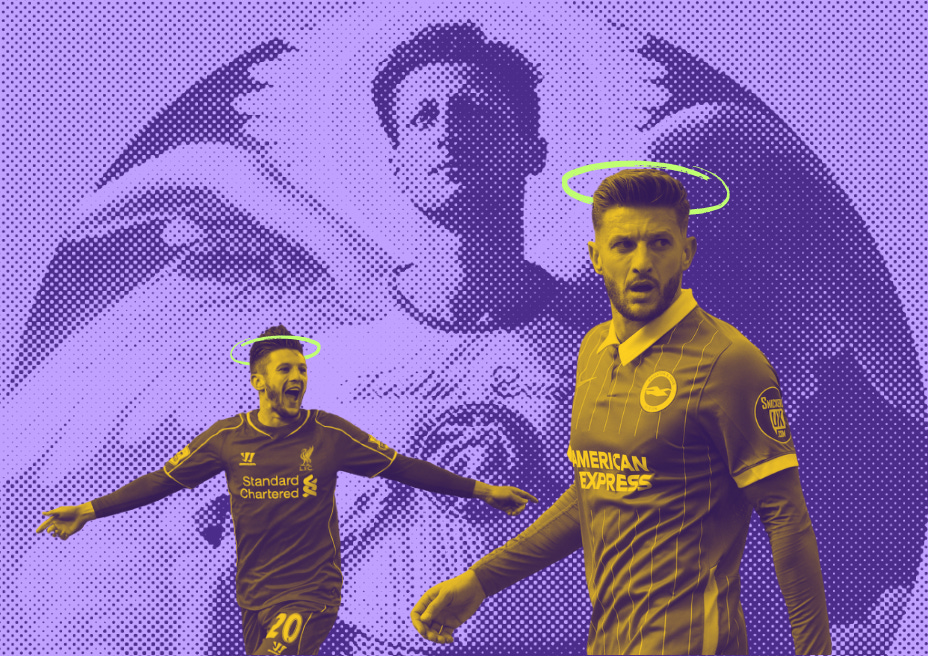Adam Lallana: A beautiful player resurrected
I use a late-career resurgence to talk about Cruyff turns
From the moment I first saw him, I have loved Adam Lallana. When I started earnestly and avidly watching football, around 2011, he was my hipster darling, the player I would knowingly suggest was destined for greatness.
“Oh, you think Gareth Bale is good? You should check out this kid playing for Southampton, in League One. Now there’s a player.”
Lallana’s game was joyful, yet intellectual. He would saunter through chaotic midfields, stealing knowing glances. From a myriad of options, he would always choose the correct one. He was an upright footballer, created from the same mould as the likes of Bergkamp, Zidane, Iniesta and Modric.
Then there was his dribbling. Despite the lack of any notable pace, he would glide past players, almost leaving the ball behind before jinking it away from nibbling limbs. In that 2013/14 Southampton side especially, he played as if listening to classical music, executing Cruyff turns destined for YouTube compilations. It’s no surprise his paternal grandfather was Spanish; Lallana would have seemed at ease cruising around the pitches of La Masia.
So, when a teary Lallana left Liverpool to join Brighton & Hove Albion on a free transfer in mid-2020, I was not hopeful. The then-31-year-old, cursed by injury, had made just nine league starts over three seasons. I was sure he was set for an unceremonious release, a mutual contract termination after a year of failed fitness tests. The name “Lallana” would be tucked amongst departing youth players in the club’s banal retained list.
As an Arsenal supporter, I had seen it before. An excellent, technical player’s career was petering out thanks to their liquorice hamstrings and honeycomb ankles. Rosický, Diaby, Eduardo, Wilshere. So long Adam, and thanks for all the flicks.
Except, thankfully, I was wrong.
At Brighton, Lallana has achieved one of the most cherished things in football: he has been resurrected.
The former England international is now the elder statesman of Roberto De Zerbi’s midfield. He is still splendid to watch, a balletic presence receiving the ball in between lines. He is now more conductor than first violin, allowing Brighton’s collection of real-life regens to buzz around him. Yet all that made him great is still there.
The resurrection is a familiar narrative in football. Italy is famous for eking the last morsels of quality out of veteran players. Messrs Baggio and Pirlo will attest. It was also a staple of Barclays-era Premier League clubs. There was Tugay, Gary McAllister, Henrik Larsson, or the entirety of Sam Allardyce’s Bolton side.
It’s worth noting that a resurrection does not simply entail an older player moving to a new club and playing well. Thiago Silva’s successes with Chelsea do not qualify, for example. Rather, popular opinion must dictate that the player is washed up, or their talent has been cruelly squandered. Defying this belief is what makes a footballing second-coming so sweet.
Unfortunately, contemporary resurrections are rare. Besides Lallana, perhaps only Willian and Danny Welbeck currently qualify. James Milner is a perfect example, but he swapped Manchester City for Liverpool nearly eight years ago.
The reason is simple. Clubs don’t trust older players anymore. Investment is geared towards potential, with most clubs scrambling for the coveted “resale value”. With pressing becoming the dominant tactical mode, teams require younger, faster, fitter players who are available for every minute of the crammed fixture calendar. There are thousands of data analysts whose spreadsheets all point to one thing: buy young, sell high, repeat.
This is sensible - I certainly do not miss the days of David Luiz and Stephan Lichsteiner wheezing around the Emirates. But this efficiency does come at the expense of romance. Like the 1998 Chicago Bulls, or Tiger Woods’ 2019 Masters win, sport needs these last dances, the final flourishes of athletes who defy naysayers to remind fans of the beauty they can produce.
There is also a depressing undertone to this: football hates second chances. Perhaps it’s thanks to games like FIFA, where progression is linear and decline is assured, or just a reflection of general attitudes towards ageing. But a culture has developed where Wilfried Zaha is considered past his peak at 30.
There are people on Twitter calling for Emile Smith-Rowe to be sold. He is 22.
If Adam Lallana has proved anything, it’s that players – and people in general – deserve second chances. Yes, that may sound like a greeting-card sentiment. But, if watching that man’s Cruyff turns don’t make you sentimental, then I don’t know what will. And I’m going to enjoy it for as long as I can.




